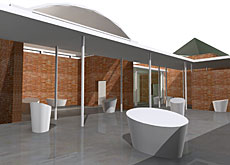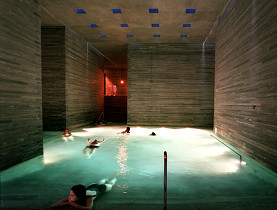Athens celebrates Tschumi’s Acropolis museum

Athens has celebrated the opening of the new Acropolis museum, the culmination of many years' work by the internationally renowned Swiss architect Bernard Tschumi.
Swiss culture minister Pascal Couchepin, who announced his forthcoming resignation last week, joined a large group of dignitaries on Saturday for the historical occasion.
Couchepin was among 400 invited guests, including European Union Commission president, José Manuel Barroso, and the Director General of Unesco, Koichiro Matsuura.
Couchepin told swissinfo.ch that he was glad one of his last foreign trips brought him to the cradle of civilization. He said he was honoured to attend the opening of the museum with a Swiss connection.
The visit is also an opportunity to raise awareness of the Swiss presence on the international stage and to exchange views with other ministers.
Heads of state and government from at least 20 European and Mediterranean countries were invited to the opening of the €130 million (SFr196 million) centre.
Greece is proud of its new museum, even though the planning and execution of the project lasted 11 years and the opening was postponed several times.
The Greek culture minister Antonis Samaras has described the Swiss-French architect’s museum as a gem. According to Samaras, the ceremony is an event of world importance.
The new three-storey museum at the foot of the Acropolis with its famous Parthenon Temple boasts 25,000 square metres of floor space. The mainly glass and steel building offers more than ten times the exhibition space of the old museum on the Acropolis.
Minimalistic approach
Tschumi decided on a minimalistic and contemporary design, he told the Swiss news agency. “The exhibited sculptures had to be the centre point. I could not allow them to be in competition with the building.”
The sculptures reflect the light while the concrete structure absorbs it. “That makes the sculptures clearly visible and very beautiful,” Tschumi added.
In the building, the architect had to overcome different technical challenges, for example the exposure to summer heat and the risk of earthquake.
Small black points have been embedded in the glass to reduce the strength of the sunlight and a system previously used in Japan and California has been incorporated to limit the risk of earthquake damage.
The official opening of the museum was originally scheduled for 2004, to coincide with the Olympic Games that took place in Greece that year. But the occasion was postponed several times for different reasons.
During excavations, walls from houses dating back to antiquity were discovered. Later there were problems with local residents as well as long-drawn out legal proceedings and finally more delays were caused by the complicated transport of the delicate exhibits from the old museum to the new.
A dual French-Swiss national with offices in New York and Paris, Tschumi won the museum contract in an international competition which included designs by prominent names such as the United States star architect Daniel Liebeskind.
Parthenon Frieze
Tschumi’s idea to create a direct view connection between the hall where the Parthenon Frieze is displayed and the Parthenon on the Acropolis hill itself was a deciding factor in the jury’s decision.
The Parthenon Frieze is the crowning glory of the museum. However a large part of the frieze has still not been returned. They were removed in 1806 by Lord Elgin, then British ambassador to the Ottoman empire. To this day 56 of the 96 slabs of the Frieze are still in the British Museum in London.
The British have always argued that there was no suitable storage space for the works in Athens. This is no longer the case, the Greeks believe. And Tschumi assumes that the slabs will be returned to Athens some day.
Until then the missing pieces will appear as blurred holograms or copies in white marble to remind people of the missing originals.
Indeed the high profile of the opening ceremony may exert pressure on Britain to give back the antique Parthenon Frieze at last.
(Translated from German by Clare O’Dea)
Born in Lausanne in 1944.
Completed his degree in architecture at the Federal Institute of Technology Zurich in 1969.
Later taught in London, Princeton and New York and has offices in New York and Paris.
The Museum of Modern Art in New York honoured the Swiss-French dual national with a special exhibition in 1994.
Tschumis’ most important works include the Parc de la Villette in Paris (1982) and the Blue Tower in Manhattan (2009).
In Switzerland he built premises for the Geneva watch manufacturer Vacheron Constantin (2004). He also produced the Flon train station in Lausanne (2008) and the Cantonal School of Lausanne (2007).
The word Acropolis is a combination of the two Greek words “akros” (over) and “polis” (city).
Most of the buildings that still stand on the Acropolis date from the 2nd to 5th centuries B.C.
The Athena Temple known as the Parthenon is the most famous building on the hill.
The Acropolis in Athens has been a Unesco World Heritage Site since 1986.
According to Unesco, the “Acropolis of Athens and its monuments are universal symbols of the classical spirit and civilization and form the greatest architectural and artistic complex bequeathed by Greek Antiquity to the world”.

In compliance with the JTI standards
More: SWI swissinfo.ch certified by the Journalism Trust Initiative













You can find an overview of ongoing debates with our journalists here . Please join us!
If you want to start a conversation about a topic raised in this article or want to report factual errors, email us at english@swissinfo.ch.